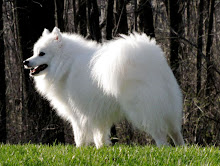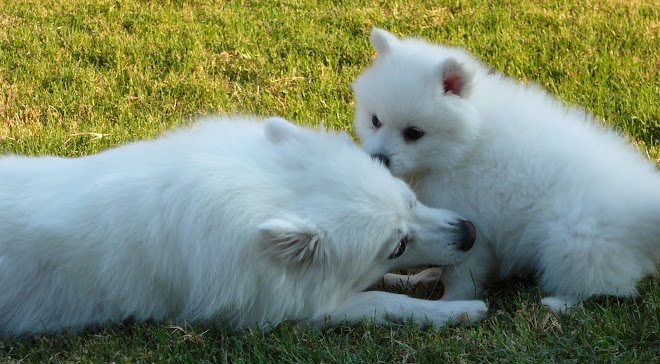February 6, 2010
Have you ever wondered how often you should clean your dog's food and water bowls? Have you ever wondered about the proper method of cleaning those bowls? The answer is not quite as simple as one would think.
The Type of Bowl to Use
First, let's discuss the best type of bowl to use. Always use a stainless steel or ceramic bowl. Plastic bowls have small groves that promote bacteria growth. Similarly, when cleaning your stainless steel or ceramic bowl, do not use an abrasive sponge, as this will cause small scratches/grooves in the bowl, making it easier for algae and bacteria to collect and grow.
The Water Bowl
Now that you have the right type of bowl, lets discuss the water bowl. Common sense says that any container that holds standing water for any period of time will breed bacteria. A common bacteria that can grow in water bowls is a reddish/pinkish slimy substance called Serratia Marcescens. This pink slime will grow in any moist location where phosphorous containing materials or fatty substances accumulate. Sources of these substances include soap residues in bathing areas, feces in toilets, soap and food residues in pet water dishes. It is important to note that Serratia will not survive in chlorinated drinking water from the tap, unless the water has been left standing long enough for the chlorine residual disinfectant to dissipate. Serratia has been found to be pathogenic to some, having been identified as a cause of urinary tract infections, wound infections, and even pneumonia.
Clean and disinfect the water bowl EVERY DAY, without exception.
The Food Bowl
Various factors determine the frequency at which you should clean your dog's food bowl. For instance, if you feed a raw food diet, you should wash and disinfect the bowl immediately after each use, so as to prevent salmonella poisoning.
If feeding homemade or a wet food, such as canned, you should wipe the bowl clean after each use, but you only need to wash and disinfect once per day.
If feeding a dry food or kibble, you can probably get by with washing and disinfecting the bowl once every other day. Of course, if your dog slobbers a lot while eating or makes a point to lick the bowl clean, you should probably go back to washing every day.
The Cleaning
A study published in the Canadian Veterinarian Journal sought to find out the best way to kill bacteria in food bowls. Scientists rubbed seven steel bowls and seven plastic bowls with a thin residue of food tainted with various bacteria, such as Salmonella. A quick rinse of warm water for 15 seconds ranked the worst. It was essentially as bad as not cleaning the bowls at all, even if wiped with a paper towel afterward.
The best method was this: Start with a warm water rinse, then scrub with dish soap (using a non-abrasive sponge), before immersing the bowl in a 10% chlorine solution for five minutes. It also doesn't hurt to run the bowls through your dishwasher once a week. To read more about the study, visit http://www.pubmedcentral.nih.gov/.
Alternative
Now I know what you may be thinking. We are a fast-food nation. I don't have time to wash my own dishes, much less my dog's food & water bowls! If you simply cannot wash your dog's bowls daily, you might want to consider having extra bowls on hand. If you keep 6-8 stainless steel bowls in your cabinet, just switch them out each day. You will only have to wash them twice a week.
Making sure your dogs always have clean bowls may cost a little more money and/or time, but the overall cost is minimal compared to the amount of time and money you will spend if your dogs contract a bacteria-related disease because his bowls are dirty. Isn't your four-legged best friend worth it?
skip to main |
skip to sidebar

Geisha, Sami, and Ju-Ju (waiting for a treat)



(7 weeks old)

(7 weeks old)






"Psssst . . . I need to tell you a secret . . . "
This blog is created by and for Japanese Spitz lovers. Sweet Samurai is a small, home-based kennel in TN. We have three JS & created this blog to help provide continual support to our friends who purchase our grandpuppies, as well as anyone who owns/loves JS. If you would like information regarding our dogs, please visit our website at www.sweetsamurai.com or e-mail us at SweetSamuraiKennels@gmail.com. To receive this blog via e-mail, type your address in the subscription field below.
Search This Blog
E-MAIL SUBSCRIPTIONS
Our Three Babies

Geisha, Sami, and Ju-Ju (waiting for a treat)
Blog Archive
-
►
2008
(12)
- ► November 2008 (8)
- ► December 2008 (4)
-
►
2009
(57)
- ► January 2009 (5)
- ► February 2009 (1)
- ► March 2009 (4)
- ► April 2009 (1)
- ► August 2009 (8)
- ► September 2009 (7)
- ► October 2009 (5)
- ► November 2009 (7)
- ► December 2009 (5)
-
▼
2010
(36)
- ► January 2010 (10)
-
▼
February 2010
(8)
- Indoor Brain Games (Entry #2 - "Laser Pointer")
- A Clean Bowl = A Healthy Dog
- COOKING FOR CANINES - #1 (Introduction)
- Dogs in Weddings
- Indoor Brain Games (Entry #3 - "RC Chase")
- COOKING FOR CANINES - #2 (The Combination Diet)
- Discount Prescription Drug Program for Your Pets
- Bathing Your Japanese Spitz
- ► March 2010 (3)
- ► August 2010 (2)
- ► October 2010 (3)
-
►
2011
(25)
- ► February 2011 (1)
- ► March 2011 (4)
- ► April 2011 (3)
- ► August 2011 (3)
Past Blog Entries - ASPCA tips
Past Blog Entries - Teaching Basic Commands
Past Blog Entries - First Aid in the Field
Past Blog Entries - Caring For Your Senior
Past Blog Entries - Cooking For Canines
Past Blog Entries - Indoor Brain Games
Past Blog Entries - Treat Recipes for your Dog
Geisha & Sami (January, 2008)

Ju-Ju (12 weeks old)

Sasuke (from our first litter)

(7 weeks old)
Izzy and Yuki (from our first litter)

(7 weeks old)
Other Interesting Links
- American Rare Breed Association
- American Society for the Provention of Cruelty to Animals
- Best Friends Animal Society
- Dogpile.com - a search engine that helps rescue pets
- Japanese Spitz Club of America
- Pet Food Recalls
- Pet Products Containing Lead
- Sweet Samurai Kennels Official Website
- Sweet Samurai Videos
- The Japanese Spitz (according to Pedigree.com)
- The Japanese Spitz Kennel Club Book
- United Kennel Club
- Yoshi (A grandpuppy from our May, 2008 litter)
Recommended References and Reading
- Japanese Spitz Kennel Club Book by Michael Rule
- The Japanese Spitz by Marco G. Piasentin
- Vet Confidential; An Insider's Guide to Protecting your Pet's Health by Louise Murray, D.V.M.
- First Aid for Dogs; What to do When Emergencies Happen by Bruce Fogle, D.V.M.
- Marley and Me: Life and Love with the World's Worst Dog by John Grogan
Ju-Ju and Sami

Reputable U.S. Japanese Spitz Breeders
Little Ju-Ju

Izzy (a puppy from our May, 2008 litter)

Kona (puppy from May, 2008 litter)
Ju-Ju (January, 2009)


"Psssst . . . I need to tell you a secret . . . "
Site Disclaimer: The information contained in this site is general in nature and has been researched and compiled from a variety of sources. It is not a substitute for professional veterinary care, and is not meant to replace the advice of veterinary care professionals. If you have specific veterinary needs, or for complete information about your dog(s), please see a veterinarian. Readers of this blog agree that neither Sweet Samurai Kennels, nor its owners have any liability with respect to any actions taken as a result of or in connection with viewing any information contained on this site. You agree to use this site and the information presented at your own risk. Some areas of our site may provide links to other external sites that we don't own, control or influence. We reference sites that we think might be useful or of interest to you, but we are not responsible for the content or privacy practices used by other site owners. Information contained in the external sites is not endorsed by Sweet Samurai Kennels, nor its owners. It is simply offered as a service to our visitors.


